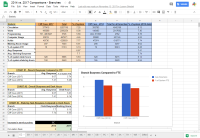Measuring Staff Busyness
St. Louis County Library, Mo.
Innovation Synopsis
St. Louis County Library administration used a statistical model to illustrate and compare the general busyness at each branch to their staffing levels.
Challenge/Opportunity
Every large library system intends to staff its branches optimally. As tasks are added and deleted from a staff person’s routine, a statistical approach is necessary to review the busyness of each location to determine which branches may need more staff, which may need less and what type of position would best suit the need. The impetus of the busyness study was to help with staffing post branch construction during our system-wide construction project.
Key Elements of Innovation
2017 branch busyness was calculated by synthesizing data of visits, circulation, programming, computer usage, holds, incident reports, new cards and meeting room usage. For each category each branch was assigned a percentage of the system. They were averaged giving an "Overall Busyness" percentage. This percentage was compared to FTE percentages for each branch. Branch Busyness is compared to the percentage of overall desk staffing hours assigned to each branch in comparison to the other branches.
Achieved Outcomes
It is anticipated that the data from these comparisons will help managers when hiring staff. HR can use this data to advise managers how to optimally allocate staff, for instance a branch that appears to be light on clerks but heavier on library assistants might choose to reallocate an open library assistant position into a clerk position to help with unmet need in that area.

